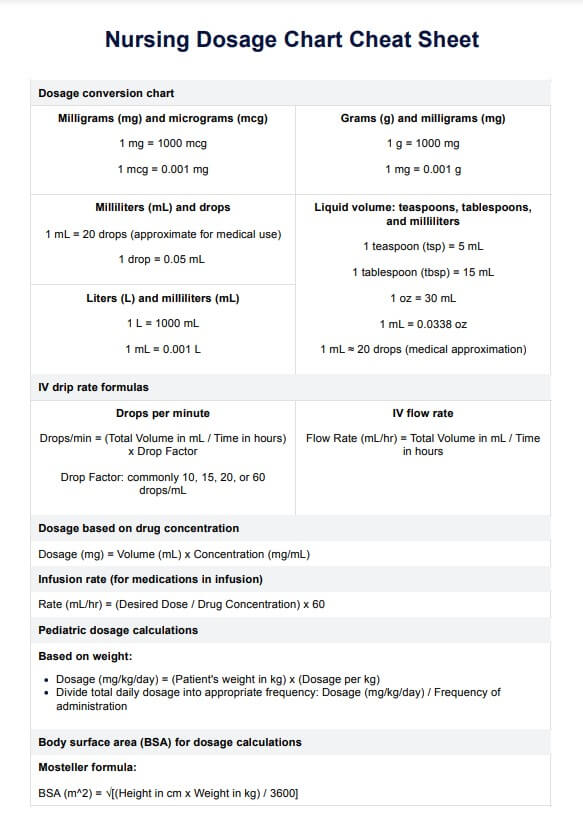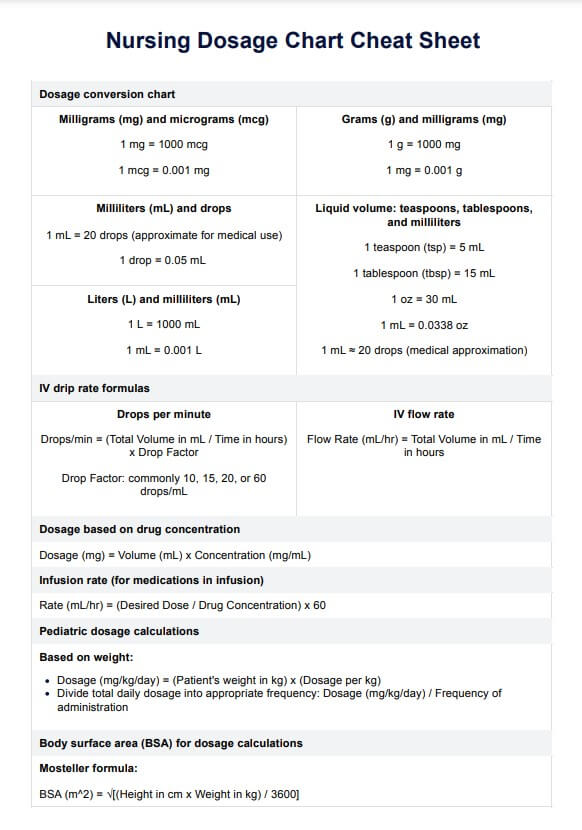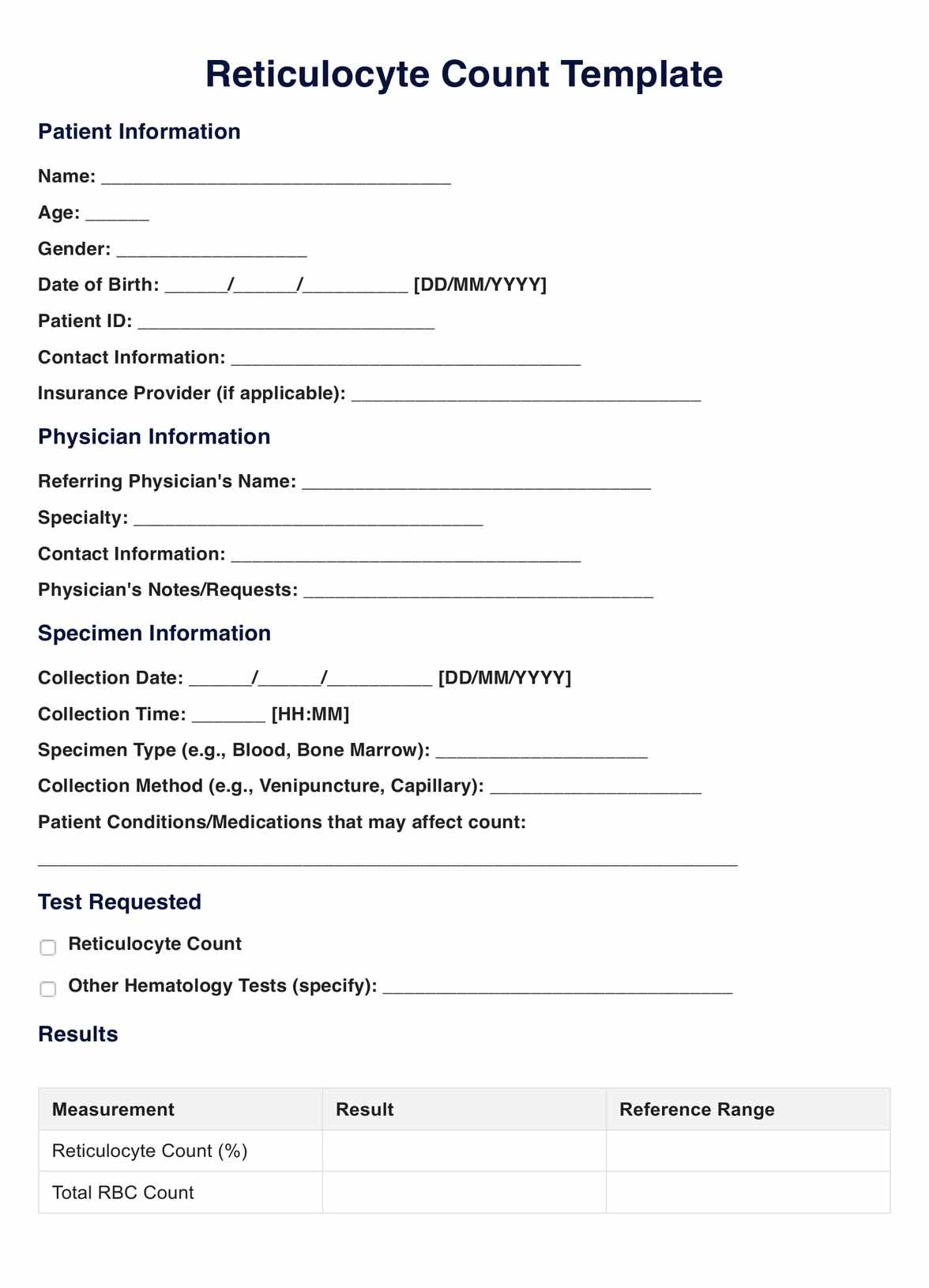Nursing Dosage Chart Cheat Sheet
Take advantage of this Nursing Dosage Chart Cheat Sheet, a quick reference tool for accurate medication dosage calculations/conversions!


What is a Nursing Dosage Chart Cheat Sheet?
A Nursing Dosage Chart Cheat Sheet is essential for healthcare professionals, especially nurses. It helps in converting and calculating accurate medication dosages in various units, such as milligrams (mg), micrograms (mcg), and milliliters (mL). For example, the chart can quickly show how to convert a dose from mg to mcg, aiding in precise medication administration.
The need for such a chart arises from the critical nature of accurate dosage calculations in healthcare. It helps prevent medication errors due to incorrect dosage calculations, which can have serious, sometimes life-threatening consequences. The chart is a quick reference to ensure correct dosages are administered to patients, minimizing the risk of medication errors.
Without a conversion chart, healthcare professionals might have to rely on memory or manual calculations, which increases the risk of errors. This can lead to incorrect medication dosages being administered, potentially causing adverse drug reactions or ineffective treatment outcomes.
The Nursing Dosage Conversion Chart safeguards against such errors by providing nursing dosage calculations, ensuring patient safety and effective medication management.
Nursing Dosage Chart Cheat Sheet Template
Nursing Dosage Chart Cheat Sheet Example
When are Nursing Dosage Chart Cheat Sheet used?
Nursing Dosage Chart Cheat Sheets are used in various scenarios within healthcare settings to ensure accurate medication administration. Here are some instances where these cheat sheets prove invaluable:
- During emergencies: Nurses need to act quickly in emergencies. A cheat sheet can provide a rapid dosage calculation or conversion, enabling prompt and accurate medication administration in critical cases.
- For pediatric patients: Children's dosages often require precise calculations based on weight. Nurses use cheat sheets to quickly convert and calculate pediatric dosages, ensuring safe and effective treatment.
- In intensive care units (ICUs): ICUs deal with critically ill patients who require exact medication dosages. The cheat sheet helps nurses in these units to accurately calculate and adjust dosages as needed.
- When administering intravenous (IV) medications: IV medication dosages need to be exact. Nurses refer to cheat sheets for correct IV drip rates and medication concentrations.
- In-home healthcare: Nurses providing home healthcare use cheat sheets to calculate dosages accurately, especially when they need to adjust or re-calculate dosages based on a doctor's new instructions.
- During patient education: Nurses use cheat sheets as a reference to educate patients or their families about medication dosages, especially when the patients are transitioning to self-care.
- In pharmacy calculations: Pharmacy staff may also use these cheat sheets to confirm or double-check medication dosages before dispensing.
- During nursing education and training: Nursing students and trainees use these cheat sheets as learning tools to familiarize themselves with standard dosage calculations and conversions.
These cheat sheets are a quick-reference tool that nurses and other healthcare professionals use to ensure they provide the best patient care by administering the correct medication dosages. One can rely on this template throughout one's nursing career!
What does this cheat sheet include?
The Nursing Dosage Conversion Chart Cheat Sheet is a comprehensive reference tool that includes essential information for converting and calculating drug dosages, as the cheat sheet includes basic conversion formulas, IV drip rate calculations, pediatric dosage calculations, and more. Here's what the cheat sheet typically includes:
- Basic conversion formulas: It covers fundamental conversion formulas between imperial and metric units, such as converting milligrams (mg) to micrograms (mcg) or milliliters (mL) to teaspoons (tsp), often using dimensional analysis for precision.
- IV drip rate calculations for IV infusions: The sheet includes formulas and shortcuts for calculating IV drip rates, essential for administering intravenous medications at the correct flow rate.
- Pediatric dosage calculations: Specific calculations based on a child's weight are crucial for determining the correct medication dosages for pediatric patients.
- Body surface area (BSA) calculations: This section often includes the Mosteller formula, which is used to calculate a patient's body surface area, which is vital for administering certain medications.
- Infusion rate calculations: The cheat sheet provides infusion rate calculations to ensure the proper amount of drug is delivered over the correct time frame for medications administered over a period.
- Liquid volume conversions: It includes conversions between different liquid volumes, like ounces to milliliters, which is helpful in preparing and administering liquid medications.
This cheat sheet is designed to be clear, concise, and easy to use. It includes conversion formulas and explanations for their application, making it a practical tool in everyday nursing practice. With this cheat sheet, nurses can quickly and confidently calculate the necessary dosage, ensuring patient safety and effective medication administration.
The benefits of using this cheat sheet
The Nursing Dosage Chart Cheat Sheet is an invaluable tool for healthcare professionals, offering several benefits that enhance patient care and nursing efficiency. Let's explore some of these advantages:
Increases accuracy in medication administration
This cheat sheet significantly reduces the risk of dosage errors and simplifies complex med math calculations. Providing quick conversion references and calculation formulas helps nurses ensure accurate medication dosages, vital for patient safety.
Time-saving and efficient
In fast-paced healthcare settings, time is of the essence. The cheat sheet streamlines dosage calculations, saving valuable time that nurses can dedicate to other aspects of patient care.
Enhances confidence and independence
A reliable reference tool boosts nurses' confidence in their calculations. It empowers them to make independent decisions and administer medications with greater assurance.
Useful for training and education
The cheat sheet is an excellent educational resource for nursing students and new graduates. It helps them learn and understand various dosage calculations and conversions, enhancing their training experience.
Standardization of care
The cheat sheet helps standardize medication administration procedures across different healthcare professionals, ensuring consistency and reducing variability in patient care.
Handy reference in critical situations
In emergency or critical care situations, where quick and accurate medication administration is crucial, the cheat sheet is a handy and reliable reference, ensuring that nurses can respond swiftly and correctly.
Utilizing the Nursing Dosage Chart Cheat Sheet can significantly improve the quality of care nurses provide, ensuring they are well-equipped to handle the complexities of medication administration in various healthcare settings.
Commonly asked questions
The Mosteller formula calculates body surface area (BSA): BSA (m²) = √[(height in cm x weight in kg) / 3600]. It's used to determine dosages for medications like chemotherapy agents.
Understanding infusion rate calculations is crucial in nursing to ensure the accurate and safe administration of IV fluids and medications. It also helps prevent underdosing or overdosing.
To convert ounces to milliliters, multiply the number of ounces by 29.57. For instance, 2 ounces equals approximately 59.14 milliliters. This conversion is essential for accurate medication administration.















































































































